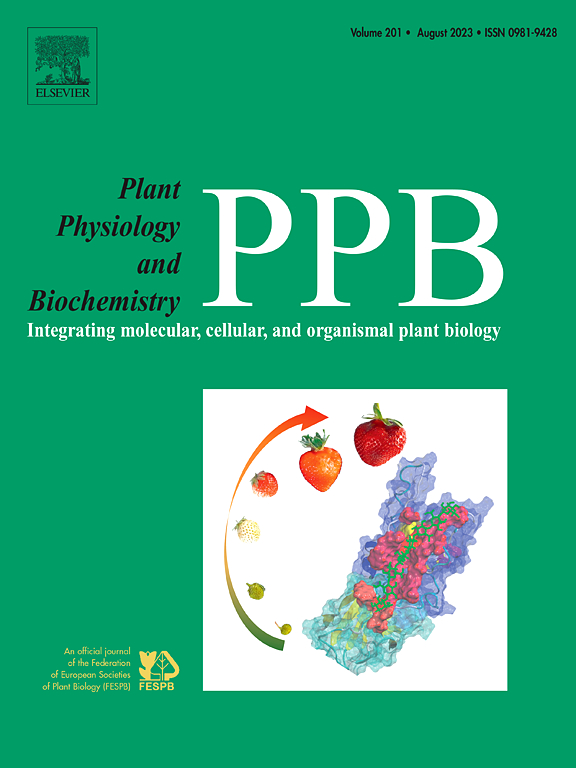生长调节因子CsGRF1和CsGRF7在黄瓜抗黄瘟中的功能分化
IF 5.7
2区 生物学
Q1 PLANT SCIENCES
引用次数: 0
摘要
作为植物特异性转录因子(TFs),生长调节因子(GRFs)在调控植物生长发育和逆境响应中发挥着关键作用。先前的RNA-seq分析显示CsGRF1和CsGRF7在黄氏Podosphaera xanthii胁迫下在黄瓜中的差异表达,提示它们可能参与白粉病(PM)抗性。然而,CsGRF1和CsGRF7在黄瓜防御中的作用和调控机制尚不清楚。在本研究中,我们研究了CsGRF1和CsGRF7在黄瓜PM防御中的功能分化。亚细胞定位、转录活性和蛋白质相互作用分析证实两者都是GRF - TF家族的典型成员。功能分析表明,CsGRF1正调控黄瓜对黄氏疫病毒的抗性,而CsGRF7则抑制其抗性。进一步的研究表明,CsGRF1通过维持活性氧(ROS)的稳态来增强抗病性,而CsGRF7通过直接与CsODO1(一种抑制PM抗性的MYB TF)相互作用来负向调节木质素的生物合成,从而降低防御反应。本研究阐明了GRF家族成员在黄瓜抗PM中的独特调控作用,为提高黄瓜抗病能力提供了理论依据。本文章由计算机程序翻译,如有差异,请以英文原文为准。
Functional divergence of growth-regulating factors CsGRF1 and CsGRF7 in Cucumis sativus defense against Podosphaera xanthii
As plant-specific transcription factors (TFs), growth-regulating factors (GRFs) play pivotal roles in regulating plant growth, development, and stress responses. Previous RNA-seq analysis revealed differential expression of CsGRF1 and CsGRF7 in cucumber under Podosphaera xanthii stress, suggesting their potential involvement in powdery mildew (PM) resistance. However, the functions and regulatory mechanisms of CsGRF1 and CsGRF7 in cucumber's defense remain unclear. In this study, we investigated the functional divergence of CsGRF1 and CsGRF7 in cucumber's PM defense. Subcellular localization, transcriptional activity, and protein interaction assays confirmed that both are typical members of the GRF TF family. Functional analyses demonstrated that CsGRF1 positively regulates cucumber resistance to P. xanthii, whereas CsGRF7 suppresses it. Further studies revealed that CsGRF1 enhances disease resistance by maintaining reactive oxygen species (ROS) homeostasis, while CsGRF7 negatively regulates lignin biosynthesis by directly interacting with CsODO1 (an MYB TF that inhibits PM resistance), thereby reducing defense responses. This study elucidates distinct regulatory roles of GRF family members in PM resistance and provides a theoretical foundation for improving cucumber disease resistance.
求助全文
通过发布文献求助,成功后即可免费获取论文全文。
去求助
来源期刊
CiteScore
11.10
自引率
3.10%
发文量
410
审稿时长
33 days
期刊介绍:
Plant Physiology and Biochemistry publishes original theoretical, experimental and technical contributions in the various fields of plant physiology (biochemistry, physiology, structure, genetics, plant-microbe interactions, etc.) at diverse levels of integration (molecular, subcellular, cellular, organ, whole plant, environmental). Opinions expressed in the journal are the sole responsibility of the authors and publication does not imply the editors'' agreement.
Manuscripts describing molecular-genetic and/or gene expression data that are not integrated with biochemical analysis and/or actual measurements of plant physiological processes are not suitable for PPB. Also "Omics" studies (transcriptomics, proteomics, metabolomics, etc.) reporting descriptive analysis without an element of functional validation assays, will not be considered. Similarly, applied agronomic or phytochemical studies that generate no new, fundamental insights in plant physiological and/or biochemical processes are not suitable for publication in PPB.
Plant Physiology and Biochemistry publishes several types of articles: Reviews, Papers and Short Papers. Articles for Reviews are either invited by the editor or proposed by the authors for the editor''s prior agreement. Reviews should not exceed 40 typewritten pages and Short Papers no more than approximately 8 typewritten pages. The fundamental character of Plant Physiology and Biochemistry remains that of a journal for original results.

 求助内容:
求助内容: 应助结果提醒方式:
应助结果提醒方式:


